Knowing the languages you translate to and from is one thing, but mastering your CAT tool and its automated quality control module is something very different. Good translators possess both of these skills.
Precision and accuracy are one of translator's nightmare, or I should rather say a poor translator's nightmare. Having to follow style guides, managing lengthy lists of terminology and spotting those pesky double spaces has made me want to scream more than once. "It should be a reviewer's job to correct my mistakes. I do not have time for this! My deadline is within an hour. How on earth am I going to find all of these double spaces?!" That is what I was thinking back then.
I finally understood I had to do something about my mistakes when for the umpteenth time my innate lack of precision and tight deadlines made me lose a client who ended up unhappy with the quality of my translation. When I say translation quality, I do not just mean poor style, incorrect grammar or improper register. It's also about broken tags, wrong numbers or unlocalized units of measure. I was utterly shocked when one of my translations was rated as a fail even if there were no "serious" language issues, but rather 5 unpaired quotes, 8 double commas and 4 small letters at the beginning of a sentence.
Several years ago, getting rid of these tiny technical issues was time-consuming and frustrating, but now I know that good translators do not make such mistakes anymore — they know how to get rid of them automatically. I admit it, I was a poor translator then. I was not aware that good translators use additional quality assurance (QA) applications or modules in computer-assisted translation (CAT) tools. Knowing the languages you translate to and from is one thing, but mastering your CAT tool and its automated quality control module is something very different. Good translators possess both of these skills.
Once a project manager told me that they do not spend time with test translations if they contain errors that can be detected by quality assurance tools. "Why should I spend time with those translations if it is clear that the translator does not have the technical skills? Translators that do not use QA tools are also very likely to be incapable of using other functions in CAT tools. We do not need non-technical savvy localizers." This is brutal, yet true. If you are sloppy with QA, there is a high chance you are also sloppy when dealing with file formats, deadlines, and other technical requirements.
So how do you get going with all the "flavors" of quality assurance in memoQ?
Let's start with something easy: Import this file and confirm the first segment. You will see there is a tiny lightning icon next to the translation.
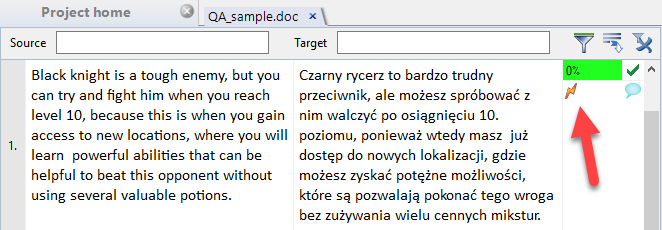
This is an indicator of a potential QA issue.
Throughout this post, I will use the term QA issue to refer to translation errors that are detectable by the quality assurance module in memoQ. But what are these exactly? These are language errors that can be automatically detected by algorithms, which at the same time are hard to spot by the human eye.
Do not think of the lightning icon as an error that you must correct. Remember this icon is flashed by a greedy algorithm that usually finds more errors then there really are. It is your job to judge whether this is a real QA issue or a false positive.
But let's get back to the lightning icon. In the translation provided, there is an error indeed. I purposely placed a double space, but the string is so long that it is virtually impossible to spot for the naked eye, even if you know there might be something wrong with this sentence. So memoQ informs you that there is a potential QA issue. Good, but not that great. How can you find out what this issue is? It is quite simple. Press CTRL+W and you will get a dialog with a description of the QA issue which reads: "Several consecutive white spaces".
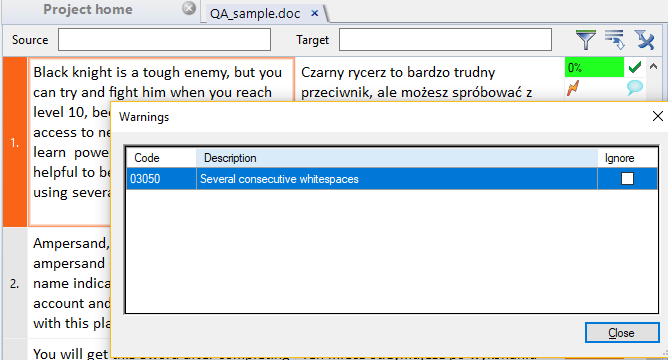
memoQ has provided more information, and you now know what to search for. However, it could still take quite some time to spot where the double space is. Instead, memoQ should tell you the exact location of this issue in your translation. To do this, you need to (get rid of current dialog with Esc key) click the Preparation ribbon (1), press upper part of the thumb up icon (2) and click OK to confirm the displayed dialogue.
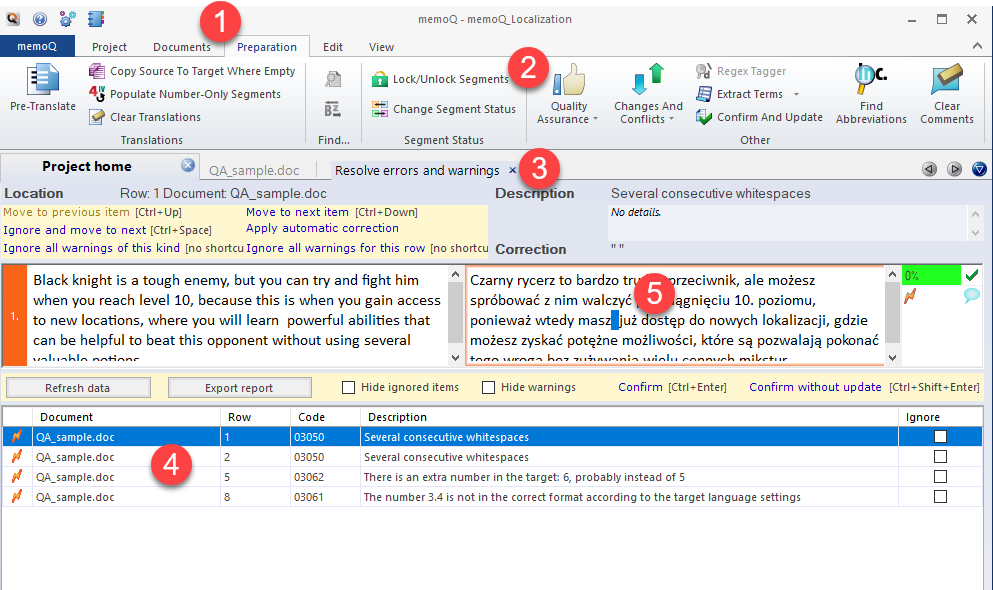
In the Resolve errors and warnings table (3) you will see all the potential QA issues (4) and often their placement in the translated segment (5). This is great, but it gets even better. Hit CTRL+ALT+SPACE and memoQ will automatically correct the double space. Now, this is what we call boosting productivity; not only does memoQ notices the QA issue, tells you what and where it is, but also allows you to automatically correct it. This is a very fine set of QA features that make up a powerful QA module. But keep in mind that not every QA issue can be fixed automatically, just the simple ones. Yet, if you need to fix about a hundred double spaces, this function could be the reason why you will still be able to keep your translation deadline.
Let's try something different. Close the Resolve errors and warnings table and return to the translation editor interface. Because we have previously used thumb up icon, memoQ has also detected QA issues in other segments. Have a look now at segment number 2. You will see that the double space here (1) is not actually an error, so you can go ahead and ignore it. To do this, press Ctrl+W again, check the Ignore box (2), and press Esc on your keyboard to close the dialogue.
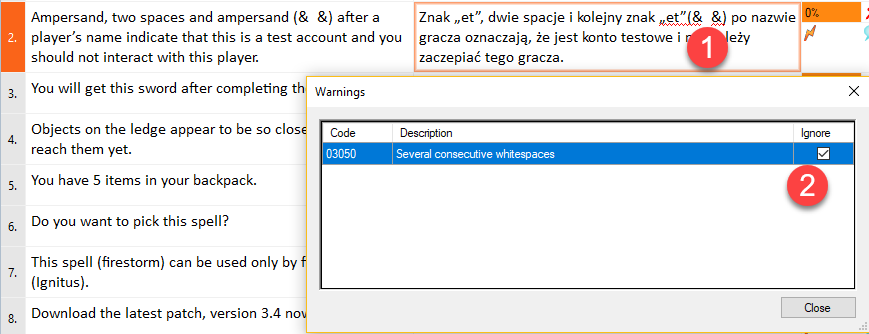
Now the color of the lightning icon has changed, and this means the issue has been ignored.

By now, you might have noticed in the Resolve errors and warnings table a small checkbox named Hide ignored items.

You can use this function to hide all the ignored QA issues in your translation and focus only on the remaining unchecked issues. This is a small feature but it is extremely useful to hide the false positive issues that you have previously ignored. It allows you to keep a clear view of issues that still require your attention.
Confirm the remaining segments.
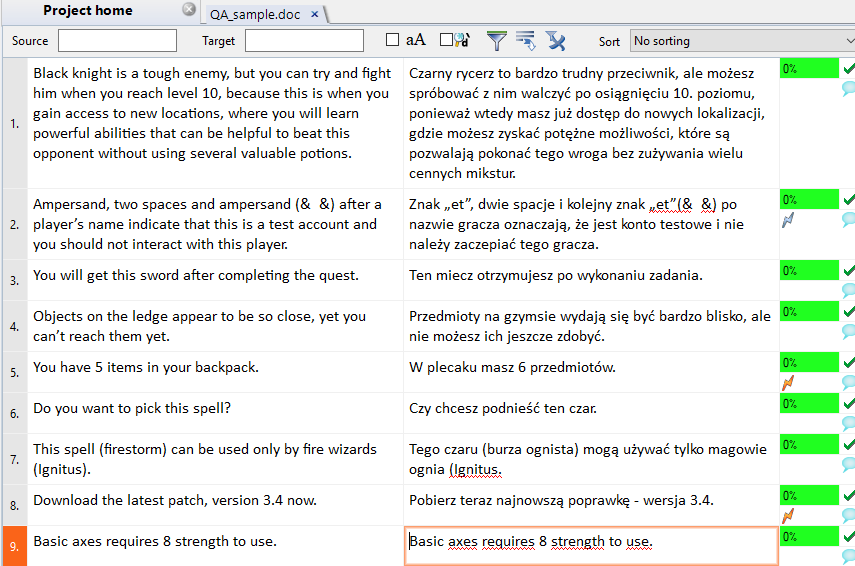
In segment number 5, there is another visible issue (wrong number) but we will leave it as it is for now. The same happens in segment 6 (different punctuation at the end of the segment), 7 (unpaired bracket) and 9 (source copied to target). The issue in segment 8 is Polish-specific. memoQ detected the version number as a decimal fraction. In Polish, decimal fractions require a comma, but there are two exceptions to this rule: version numbers and numbers of subchapters. Therefore, the issue in segment 8 is not really an issue, but a false positive. I told you, automated QA algorithms are greedy!
The translation is now ready and it is time to run some QA checks. We did not correct the issues as they appeared during the translation process. This is one way of doing things (with CTRL+W) and some translators prefer to work like that. Personally, I prefer to first finish the translation and then to get rid of errors. This batch approach can be done in two ways:
- use the thumb up icon and correct the issues listed in the Resolve errors and warnings table,
- filter only the segments with QA issues and display them in translation editor.
We have already tried the first method, so let’s test the second now.
1. Click the funnel icon.
2. Change to Status tab.
3. Check the Unsuppressed warnings box
4. Click OK.
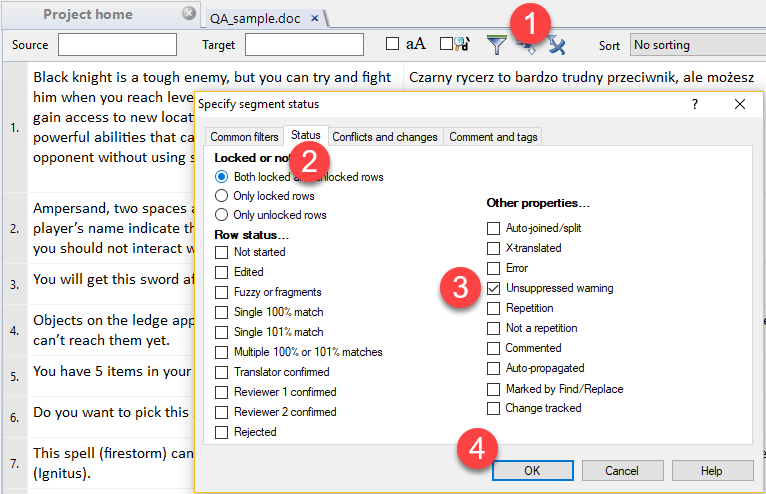
The editor will now display only segments with unignored issues, so you can correct or ignore them one by one and finish your translation.
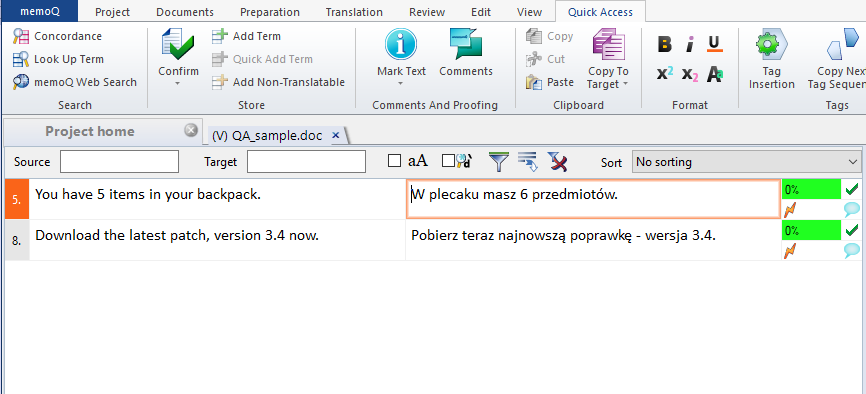
However, we previously noticed that memoQ missed a few obvious QA issues (segments 6, 7 and 9). memoQ could not spot them because the default QA configuration is limited, but you can customize it before you start a translation. We will now adjust the QA configuration to help memoQ detect the remaining errors.
To do so, follow the instructions here:
1. Click Project home -> Settings panel.
2. Click QA settings icon. You will see that the Default configuration cannot be edited.
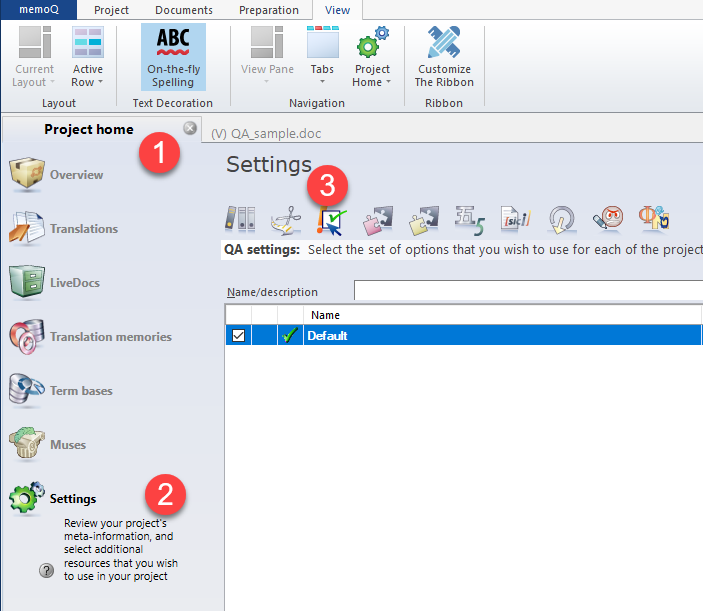
3. Nonetheless, click the Edit button (3) and memoQ will ask if you want to clone this resource.
4. Click Yes and give a new name to your QA configuration (First_Config) (4).
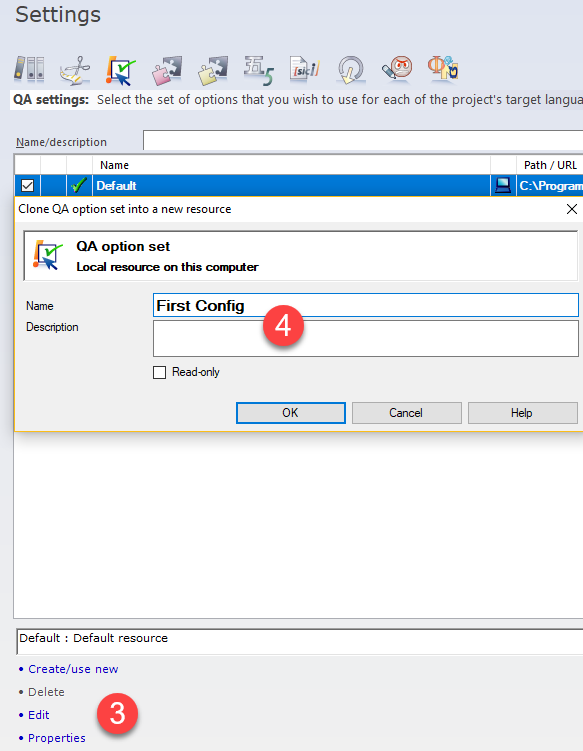
5. To activate your new configuration, click the checkbox to the left of the name. Then click Edit to display Edit QA settings dialog.
6. You will see there are several tabs with QA options that will allow you to find almost any imaginable issue. And if there is no pre-configured option you can create custom rules using regular expressions (Regex tab).
7. The first issue we want memoQ to flag is when the source text is copied to the target segment. To activate this setting open Segments and terms tab (1). Now check Warn if target segment equals source segment (2).
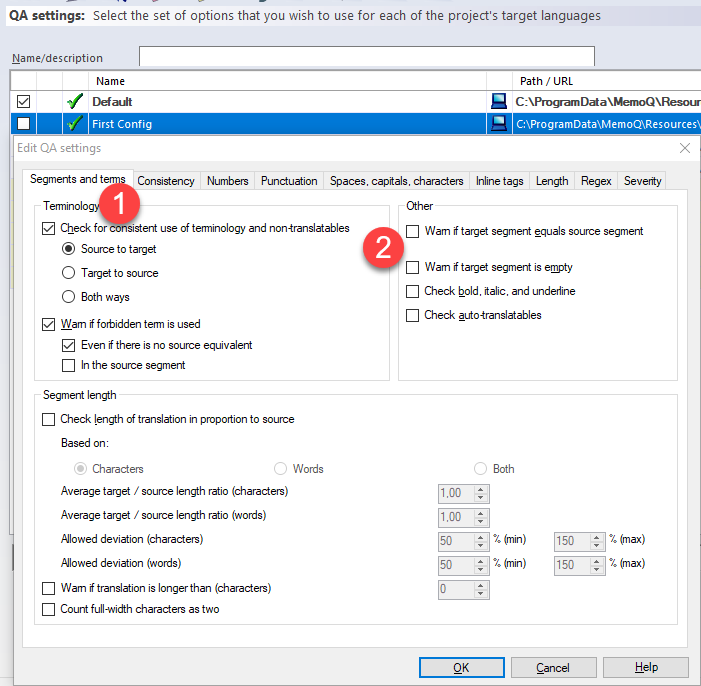
8. Next click Punctuation tab (1) and check Verify that source and target segments end with the same punctuation mark (2).
9. Finally click Warn for missing brackets, quotation marks and apostrophes.
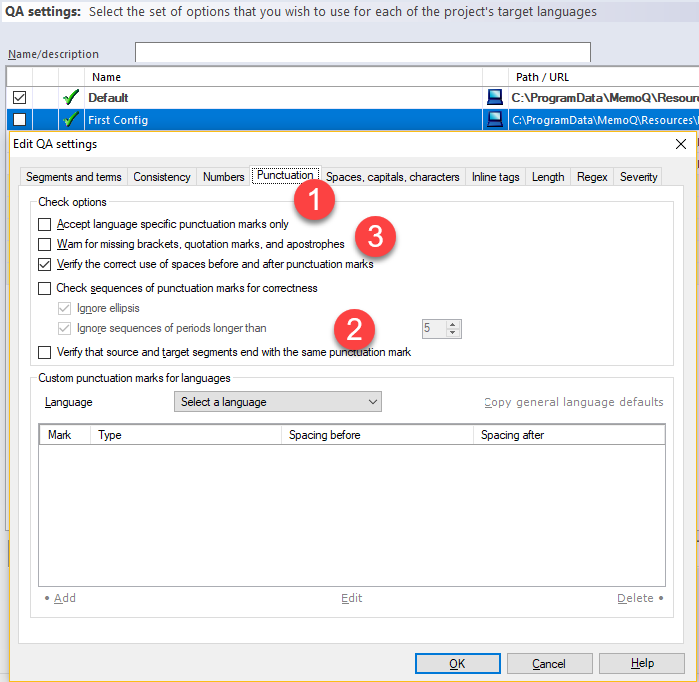
10. Click OK to confirm your changes and get back to editor.
Now memoQ should be able to detect the QA issues in segments 6, 7, 9. So click thumb up icon, press OK and look for these issues in the Resolve errors and warnings tab.

Indeed, everything is OK. All QA issues are now detected.
As you have probably noticed, there are several more tabs with other QA issues to detect. We will not describe each and every one of them in the blog post, but please have a closer look and take the protective measures that will bullet-proof your translations against the issues that occur most frequently to you. Perhaps you have a tendency to mix up terminology, use forbidden characters (in Polish, for instance, using # for "number" or & for "and" is not allowed) or just want to control the charater limit. You should customize the QA options according to your particular needs and avoid using the default configuration or your “hawk eye” when checking for mistakes. The same goes for detecting and correcting issues — use the method that you find most effective.
And how can you use QA in memoQ? However you wish.
1. You can translate the whole text and do not pay attention to QA issues or lightnings icons because you feel more comfortable to deal with them when once you have finished (using the Resolve errors and warnings table).
2. You can press Ctrl+W and correct (or ignore) each QA issue as they appear in your translated segments.
3. Once you have finished translating, you can filter only segments with QA issues and fix them in the translator editor.
4. You can mix the above methods and used them like you wish!
This is what I really like in memoQ - there is no one "holy" method or set of options to tackle the problem. You have access to several methods and you can solve problems in many different ways.
So please, avoid being a sloppy translators like I used to be and use the QA features in memoQ to deliver high quality translations both in terms of style and grammar... and do not forget about the pesky double spaces

Michał Tosza
English to Polish software and game translator, part-time university lecturer and educator, CAT tools' evangelist who localized his first application back in 2005. Now he is focused on supporting indie game developers in preparing their games for localization. With more than 15 million words translated, reviewed, post-edited and localized he always seeks new ventures to take part in.




